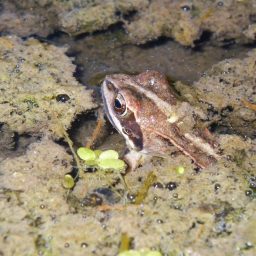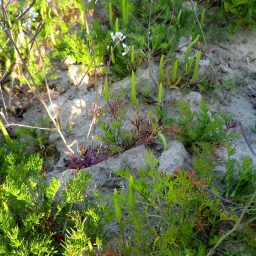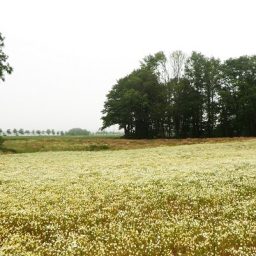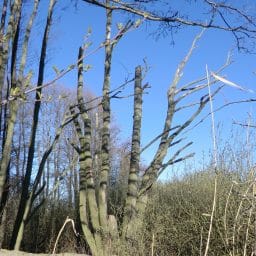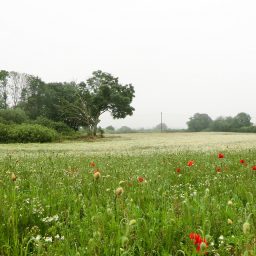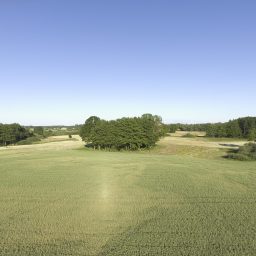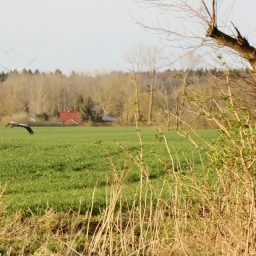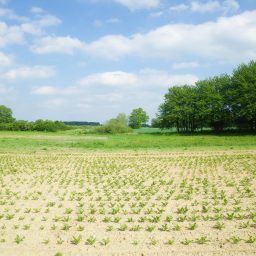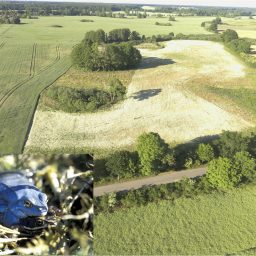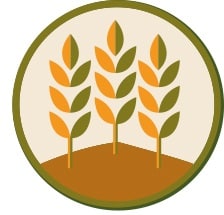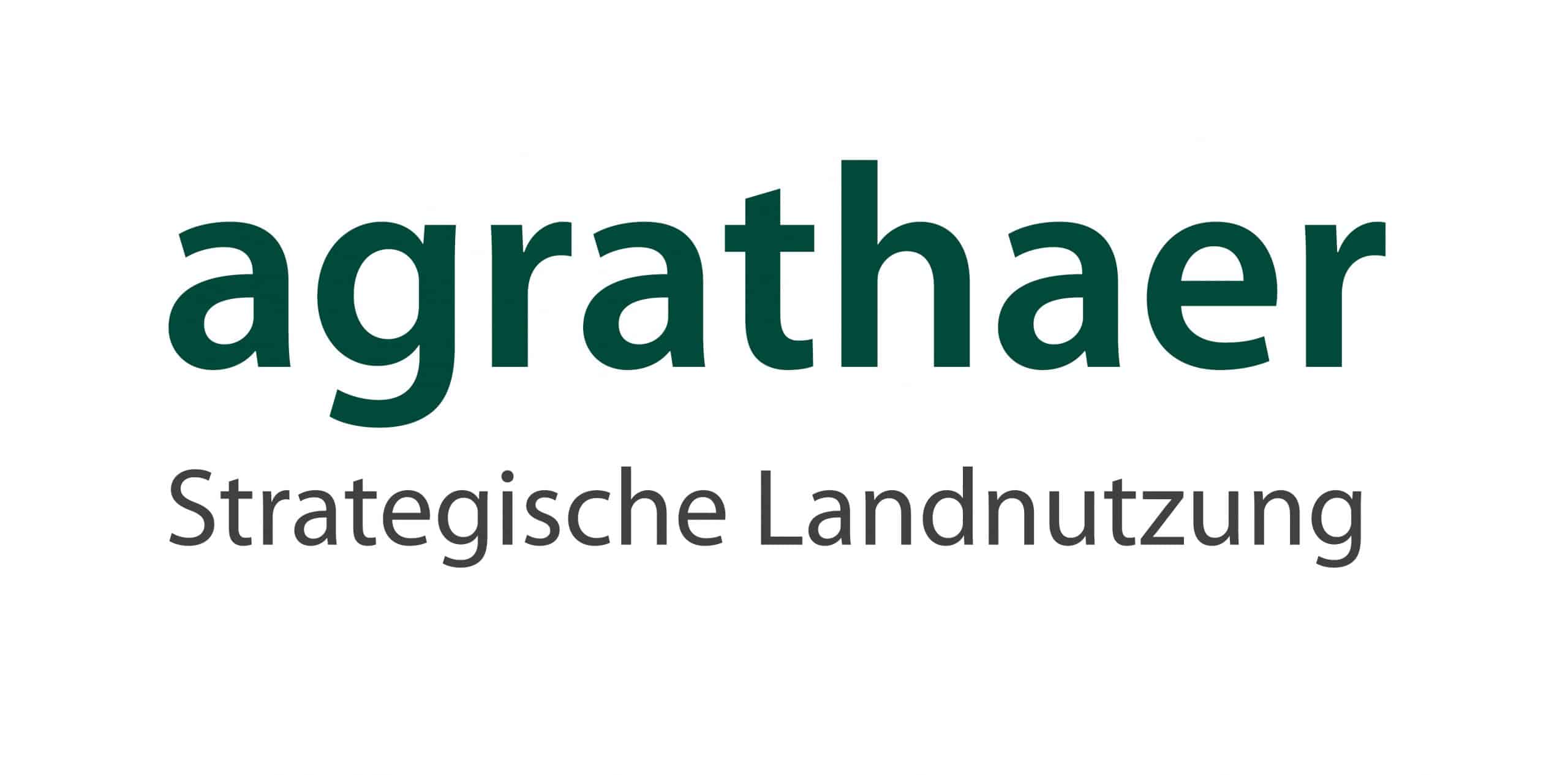Moor Frog Islands near Sestelin - Part 2 (Year 1)
Protection of amphibians on arable land rich in small water bodies
In implementation
Our aim is to create a refuge for endangered amphibian species. This should benefit, among others, the moor frog, which is typical for north-eastern Germany. We also want to specifically promote insects and rare field wild herbs.
Über das Projekt
Initial situation
The project area is located on a sandy field with a large number of small water bodies. After the sugar beet harvest in autumn 2019, an area of 3.5 ha was taken out of use as an ecological priority area to protect amphibians. This area includes or borders a total of four temporary small water bodies of very different structure. In this way, spawning waters, summer habitats and hibernation structures for amphibians are interconnected.
Why here?
The municipality of Dargelin, where the project area is located, is characterised by its high occurrence of "Feldsöllen" (hollow forms shaped by the ice age and temporarily carrying water) and thus offers important habitats for endangered plant species, dragonflies, water beetles and amphibians. With about 100 field hollows and other small water bodies per square kilometre, Dargelin is one of the most structurally rich agricultural landscapes in the Greifswald hinterland. The potential for supporting endangered amphibian populations is accordingly high. In spring 2019, the occurrence of moor frogs and green frogs in the small water bodies within the project areas has already been confirmed. The song of tree frogs and the mysterious "toc toc toc" of the spadefoot toad can also be heard in the area in spring. The banks of the small water bodies offer a variety of nesting opportunities (not only) for wild bees and other insects. The planting of a perennial bee pasture in the immediate vicinity is planned as a further enhancement of the wild bee habitat. Already in the first year after the abandonment of use, the arable fields are home to arable wild herbs worthy of protection, e.g. the mouse-tail (Myosurus minimus) and the sand poppy (Papaver argemone), which are also included in the list of forewarned species in Mecklenburg-Western Pomerania.
What would happen without the project?
On the recommendation of our nature conservation advisor and with the prospect of funding from AgoraNatura, we decided last year to take the areas out of use temporarily on a voluntary basis as EFA fallows. Without financial compensation, however, we cannot abandon the cultivation of the areas in the medium and long term, and conventional farming with the use of mineral fertilisers and pesticides would have to be practised again on the protected areas.
Amphibians present on the farmland at the time of cultivation would be exposed to a high risk of injury or death, both through annually recurring intensive tillage and through the application of mineral fertilisers and plant protection products. The current amphibian populations would be weakened, and the spread of wild field weeds worthy of protection would be suppressed.
Concrete measures
This offer is part of an overall complex of 3.5 ha, which is divided into three different management units: (i) self-vegetated fallow for amphibian protection; (ii) perennial bee pasture (iii) establishment of an extensive field for the promotion of arable wild herbs. The establishment of the extensive field, a perennial bee pasture with regio-certified seeds and a first section of amphibian fallow are part of the first sub-offer and have already been financed. The bee pasture was sown in April 2021 and is already starting to germinate.
This partial offer focuses on an expansion of the self-vegetated fallow land for amphibians by 1.5 ha:
- as an interconnection between the field tarns/small water bodies
- No soil cultivation, no use of pesticides and fertilisers
- Mulching or maintenance mowing no more than once a year after 15 October (by this time the amphibians have already retreated to their winter quarters and can no longer be harmed).
A continuation and further financing of the project beyond the first three-year project phase is sought. In order to maintain the status of arable land, ploughing up of the area (or parts of it) is possible in some years as an exception. The most favourable time for this will be agreed with the project's nature conservation contact persons.
The project area is directly adjacent to three field marshes and a large sedge reed, all of which are protected biotopes.
Protected species
The moor frog (Rana arvalis) is a typical amphibian species in north-western Germany. A special attraction is the intense blue colouration of the males during the mating season. Due to a loss of wetlands and sufficient refuges in the agricultural landscape, its population is endangered in many regions. Like most native amphibian species, it is on the Red List throughout Germany. In Western Pomerania, moor frogs are fortunately still relatively common in the agricultural landscape - at least in not too dry years. We want to work to ensure that moor frogs and other protected animal and plant species find sufficient habitats in our region in the long term.
You invest in the following ecosystem services:
- Moor frogs (endangered according to Red List Germany and MV)
- Pond frogs (endangered according to the MV Red List)
- Tree frogs (endangered according to Red List Germany and MV)
- Lesser Spotted Eagle (potential foraging area within 3 km radius)
- Old pollarded willow, other woody plants, deadwood and reading stone piles at the edge of the temporary small water bodies provide nesting and retreat opportunities for numerous animal species
- Aphanes arvensis (Common lady's mantle)
- Myosurus minimus (Small mouse tail)
- Papaver argemone (sand poppy)
- P. dubium (seed poppy)
- Veronica hederifolia (Ivy Speedwell)
- Scleranthus spec. (annual knawel)
Further important species: Geranium spec. (cranesbill), Erodium circutarium (common heron's beak), Lamium purpureum (purple deadnettle), Matricaria chamomilla (true camomile), Papaver rhoeas (corn poppy), Rumex acetosella (small sorrel), Spergula arvensis (field park), Vicia spec. (vetches) as further HNV species.
Particularly supported are- Valuable arable wild herbs, HNV species Arable land/fallow land
Wild herbs (spontaneous species), field copses 6 species
Special habitat structures- Mouseholes, pithy stems approx. 2000 m²
- Adjacent: Reading stone piles, standing and lying deadwood n.a.
- Adjacent: grass felt in the reeds approx. 1500 m².
No use of insecticides
Per certificate: 0.4 - 0.8 kg N Ground water services (estimation/literature based value)
Total project: 60 - 120 kg N Ground water services (estimation/literature based value)
So everyone can experience the ecosystem service
- The area is accessible via a public street or path.
- Activities of environmental education and experiencing nature take place on / around the area.
The municipality of Dargelin is hardly developed for tourism. The beautiful landscape and roads with very little traffic are inviting for cycling tours, among other things. There is a table and benches for picnics right next to the project area. Especially during the evening hours, lingering here is very atmospheric and numerous animals can be observed.
Documentation in the implementation phase
The project starts on 01.01.2022 and exactly goes 1year , provided all certificates have been sold.
You will be regularly informed about the progress of the project. For this purpose, the providers can provide short news, picture or audio material. The providers are obliged to report at least once a year whether everything went well with the implementation. If there are difficulties from your point of view, please contact us, the provider itself or the certification body.

